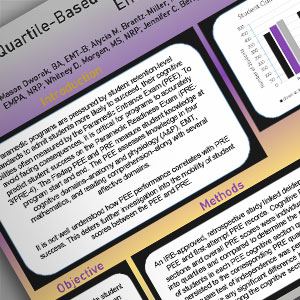ABSTRACTS
Quartile-Based Student Performance Trends Between Paramedic Entrance and Readiness ExamsAuthor: Mason Dworak BA, EMT-B | | Associate Authors: Brantz-Miller, Alycia, M, MS NRP | Rollman, Jeffrey, E, MPH NRP | Khalsa, Sahaj, BS NRP | Martens, Eric, A, BS EMPA NRP | Morgan, Whitney, D, MS NRP | Berry, Jennifer, C, BA | Fentress, Thomas, L, MBA NRP PI CFI | Dinsch, James, D, MS NRP CCEMTP
Introduction Paramedic programs are pressured by student retention-level standards to admit students more likely to succeed, their cognitive abilities often measured by the Paramedic Entrance Exam (PEE) from Fisdap (an online EMS database). To avoid facing consequences, it is critical for programs to accurately predict student success on the Paramedic Readiness Exam (PRE3/PRE4). The Fisdap PEE and PRE measure student knowledge at a program’s start and end. The PEE assesses knowledge in four cognitive domains- anatomy and physiology (A&P), EMT, mathematics, and reading comprehension– along with several affective domains. It is not well understood how PEE performance correlates with PRE success. This deters further investigation into the mobility of student scores between the PEE and PRE. Objective To investigate student mobility between PEE cognitive domain scores and PRE success. Methods An IRB-approved, retrospective study linked de-identified PEE and first-attempt PRE records. Cognitive PEE sections and overall PRE scores were individually split into quartiles and compared to determine the proportion of students in each PEE cognitive section quartile who persisted to the corresponding PRE quartile. A chi-square test of independence was performed to determine any significant difference in persistence among the cognitive sections. Results A total of 1,185 students met inclusion criteria for analysis and were split into four quartiles. Student quartiles remained most persistent in A&P, but there was no significant difference between cognitive domains. A&P: 34.43%, Math: 31.05%, Reading: 30.72%, EMT: 28.86%, x2=4.625 (p=0.201). Discussion The results indicate that quartile-based examination of test performance usually shifts between the PEE and PRE. Given the small sample size, the results might be hard to generalize, but paramedic educators should be encouraged to recognize that low or high PEE performance is not necessarily indicative of future PRE performance. Conclusion Paramedic educators should be aware that the performance of most students, as measured by PEE then PRE, changes over time.
|

